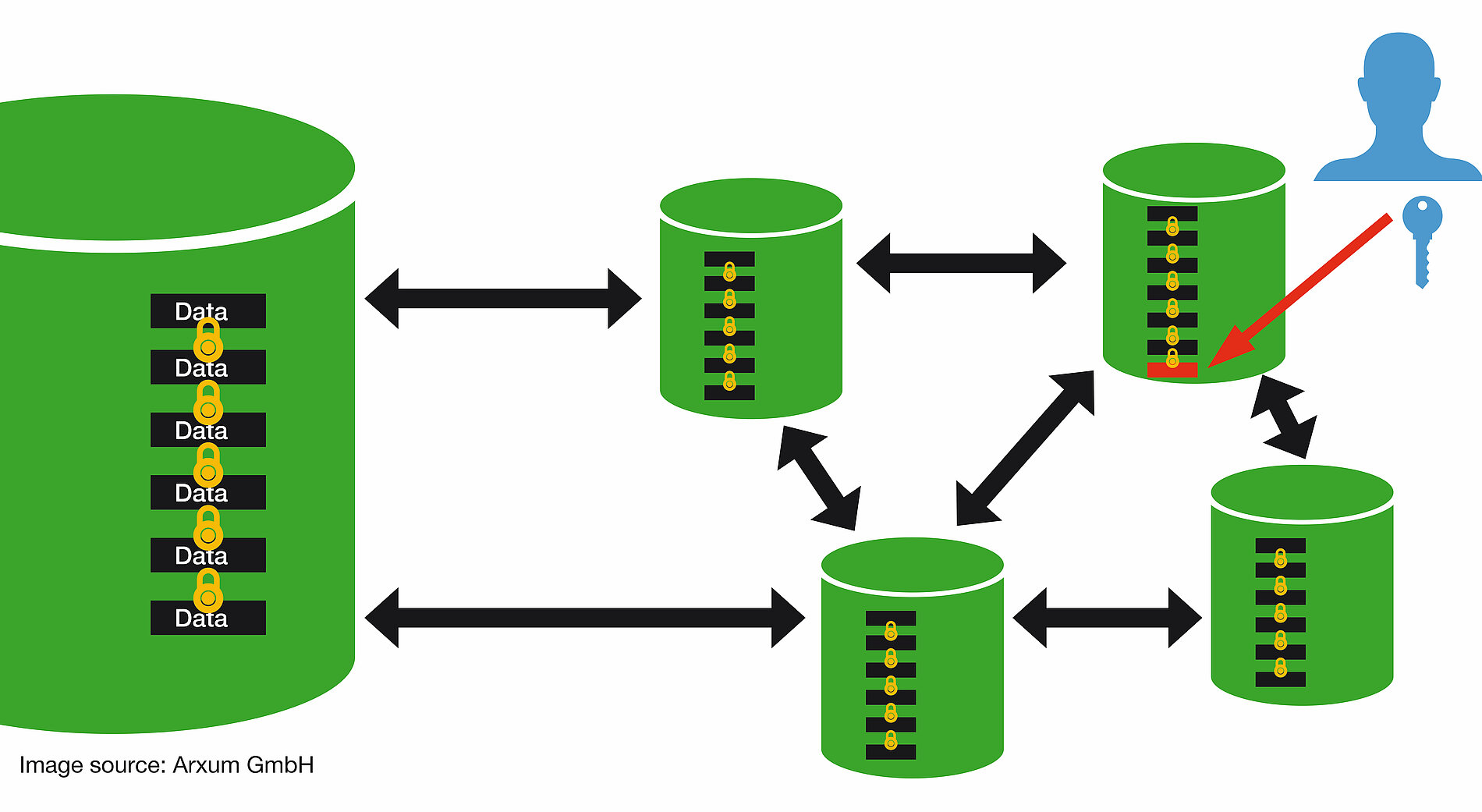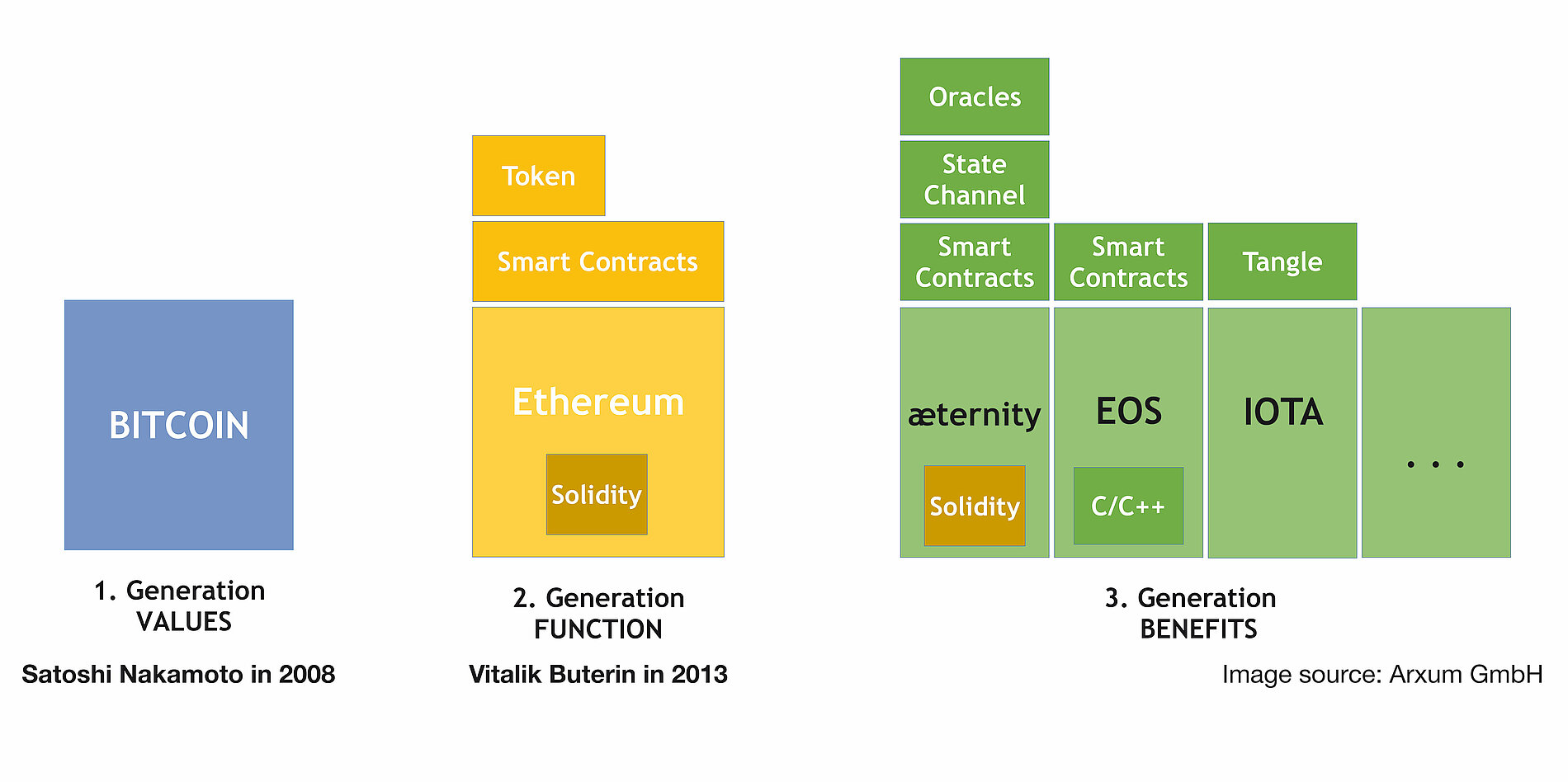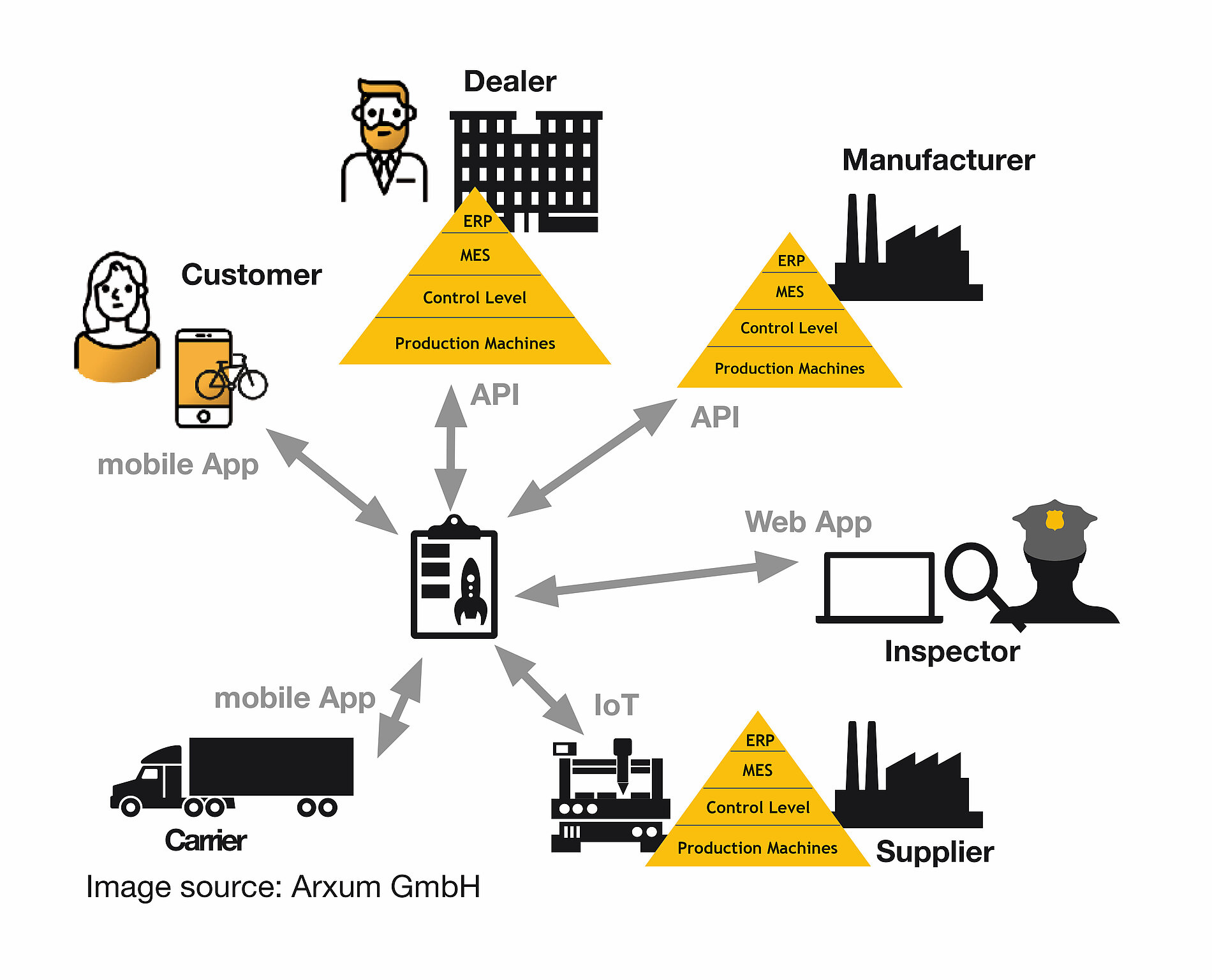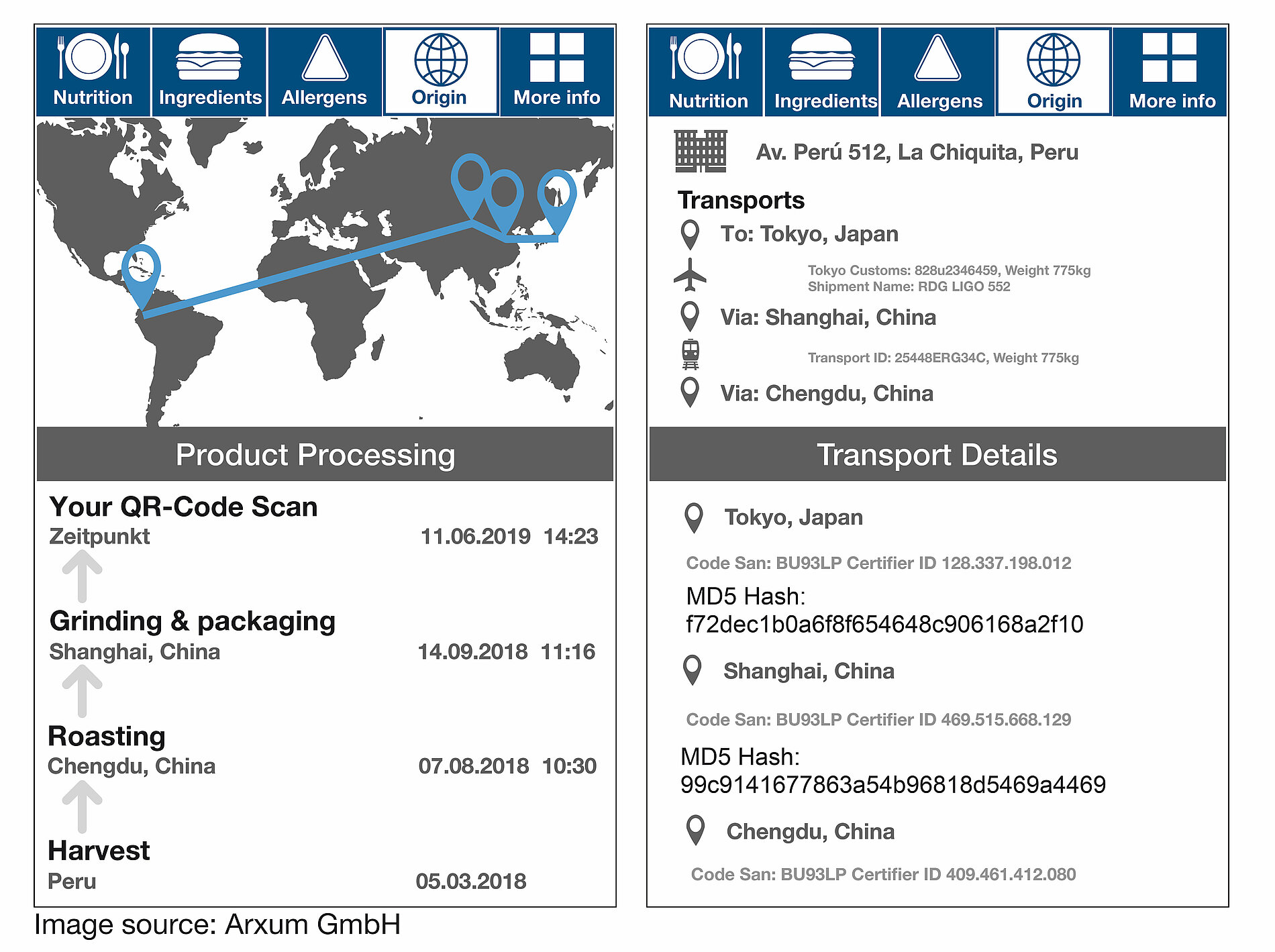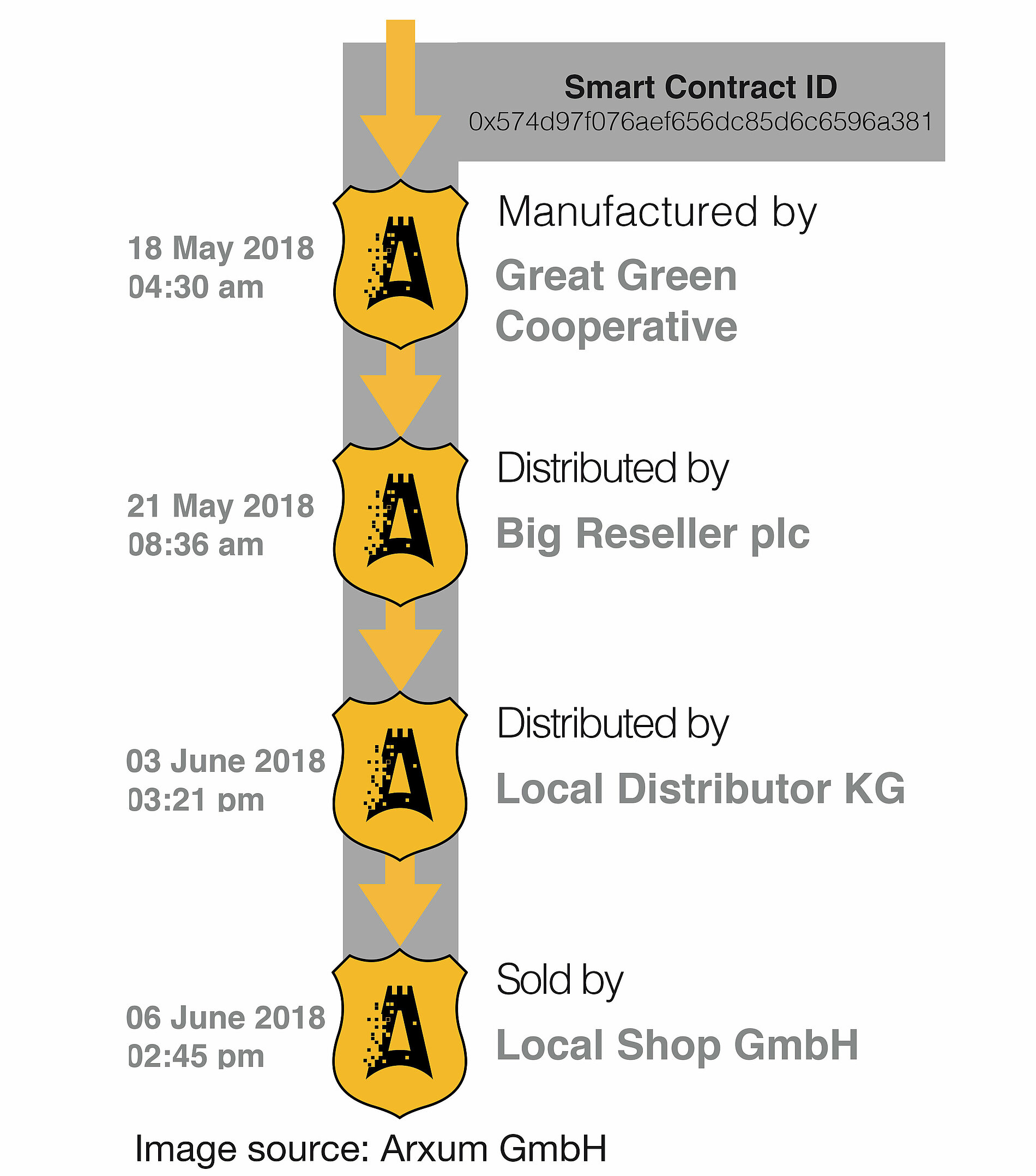Blockchain in the Food Supply Chain - Basics, Practical Examples, Perspectives
DLG-Expert Report 06/2019
Content
- Introduction
- Fundamentals of distributed ledger technology
- Consensus protocol
- 3rd generation distributed ledger technology
- Inter-company data exchange
- Applications in the food sector
- Supply chain applications
- Distributed ledger in the food supply chain
- More than just a single advantage
- Comparison with existing technologies
- Outlook and conclusion
- References
- kontakt
Introduction
Blockchain technology, or distributed ledger technology (DLT), has been receiving increased attention recently. The “blockchain” became known, among other things, through the euphoria surrounding the cryptocurrency Bitcoin, which reached its peak at the beginning of 2018. The blockchain technology underlying Bitcoin is so secure that no one has succeeded in stealing Bitcoins from accounts that they did not hold the keys to for ten years.1 A blockchain is now regarded as an absolutely forgery-proof data repository that functions “trustlessly” – i.e., without any necessary reliance on a central controlling authority. As a result, many people have been looking into the technology since that time and wondering what exciting applications can be realized with the basic technology DLT apart from cryptocurrencies.
Interestingly, there are some very exciting applications here in the supply chain sector and especially in the food supply chain sector. This is because in the food industry, trust in the product and brand is considered one of the strongest currencies.
1 Those spectacular thefts of large amounts in the millions were always based on the theft of the access keys to the Bitcoin accounts.
This meant that strangers had access to bitcoin holdings, which were of course stolen. However, the underlying Distributed Ledger System,
which was used to manage Bitcoin‘s accounts, has never been cracked.
Fundamentals of distributed ledger technology
DLT is an intelligent combination of already existing technologies that has been composed into an autonomously acting application through the computing power and networking bandwidth available today. Originally designed for transactions only, as in a ledger, today different data can be stored in a ledger. These data entries are connected to each other via mathematical-cryptographic algorithms. There are often two roles in the blockchain network: Users send transactions to the blockchain and so-called “miners” or “block producers” take the transaction data and persist it in the ledger. The central element is the so-called hash value, a number that is calculated from a data block. This hash value has the function of a digital fingerprint of its original data, since the hash value changes completely if even a single bit is manipulated in the original data.
In this way, not only are fingerprints of the individual data entries created, but also several data blocks are always grouped hierarchically in a so-called Merkle tree and a hash value is generated again from each level. This creates a link between the data via the associated hash values. In the end, a certain number of data entries and the corresponding hash values are combined in a block and a single, corresponding block hash is generated.
This block hash is the first data entry of the following block, in which all newly added data entries are then stored in the same way. The blocks are therefore chained via the hash values, thereby becoming a blockchain. In the event of a subsequent manipulation of an already incorporated data package, all subsequent hash values would no longer match the respective data, which is very easy to detect. In order to guarantee security, a large number of copies of the database created in this way are distributed on various computers around the world. Another part of the distributed ledger technology is the automatic synchronisation of data copies. In other words, it doesn’t really matter which copy of the data one interacts with. In the course of data synchronisation – depending on the implementation – all hash values are checked and false or manipulated copies are detected and corrected. The majority principle applies, so to speak, so that a serious attacker would have to bring more than 50% of all data copies under his or her control in order to implement a desired manipulation.
A cryptographic key is needed to interact with the blockchain, i.e. to store data, send transactions and, if necessary, also to query data. Data can only be entered with this key and every interaction leaves documented traces on the blockchain.
Consensus protocol
The connection and matching of the many copies is carried out via the so-called “consensus” protocol. This defines the rules according to which blocks are compiled and which cryptographic procedures are to be used. For Bitcoin, for example, the SHA256 algorithm has been defined, which the miners must use to persist the data blocks in the ledger. This has the property that it can be applied very quickly and easily to a data block, i.e. it calculates its hash value, also known as the digital fingerprint. However, the hash value cannot be anticipated, estimated or otherwise predicted. If only one bit in the data block changes, the hash value takes on a completely different value. This is used in Bitcoin, for example, by the consensus to define what is a “suitable” hash value. This must, by default, be less than a certain number for any data block (i.e. a collection of transactions), in other words, it must start with a series of zeros. But as the hash value cannot be estimated, the miners have no choice but to find a suitable hash value of a data block by trial and error. If the hash value does not meet the required criterion, there is a data field, the so-called “nonce”, which the miners are allowed to change in order to generate another hash value. They do this until the data block of transactions with a matching nonce yields a hash value that meets the required criterion. The miner “publishes” the transaction block with the found nonce for all other miners who are also currently still searching for a matching nonce. A simple calculation of the block hash is sufficient to check the matching hash value, and this allows all other miners to confirm the “mined” block that has been found. All transactions in it are now in the blockchain and the remaining miners start again by taking unmined transactions and searching for the next valid nonce or matching hash value for them.
This consensus procedure called “proof-of-work” has a high energy consumption due to the many hash calculations, which can be on the scale of that of a small country for Bitcoin alone. It does, however, make the Bitcoin Blockchain very, very secure, as attackers would theoretically have to spend so much computing power (i.e. energy) to outperform that of all other active miners (i.e. at least 51% of the total power).
The fact that this consensus procedure cannot be used sustainably and economically in an industrial application was soon recognised and a new generation of blockchain technologies has developed much more efficient consensus procedures [1] here.
3rd generation distributed ledger technology
After the emergence of the first generation through Bitcoin, in which only values were stored, the second generation of blockchain applications emerged in 2013 with Ethereum. The phenomenal innovation here was the introduction of so-called smart contracts. These are scripts that can perform fully automated value transactions after certain conditions programmed into them occur. Since the code of this smart contract is also stored on the blockchain itself, no one can change or even stop the execution of the script in their favour without being noticed. As always in DLT, this requires the cryptographic keys approved for this purpose.
Ethereum’s programmability has led to the widespread success of distributed ledger technology. New business models can be implemented here as so-called “distributed applications” or “DApps”. The system is accessible to everyone and use is only paid for according to transaction costs. However, due to the proof-of-work consensus procedure also used here, the transaction costs are quite high at around 20 US cents per transaction and the entire system can currently only process around twenty transactions per second worldwide. This is undoubtedly too weak for an industrial application, which is why the system is currently being used to try out technical ideas and so-called proof-of-concept projects.
Since around 2015, an accomplished community of developers, mainly from the university environment, has set out to develop and test new concepts and technologies in order to make distributed ledger technology suitable for intensive, industrial application scenarios. In particular, new consensus mechanisms have been developed for this purpose, which establish the consensus of all nodes in the distributed system when matching all copies as to which data in the blockchain is valid, i.e. which version of the blockchain is the “true” one.
While Bitcoin and Ethereum use the proof-of-work method, in an industrial context, however, only an efficient and energy-saving method can be used that works quickly and economically, but must offer comparable security and reliability. Various procedures have emerged here. In the proof-of-stake process, those miners who have high stakes to lose and therefore have a vested interest in security and system integrity decide on the blocks. In the delegated proof-of-stake process, the formation of blocks is delegated to a small selected group of miners to increase efficiency. Elaborate calculation procedures to find a suitable nonce with the associated energy consumption are therefore not necessary here. Transaction costs have dropped far into the sub-cent range, and since only a few miners are involved, many thousands of transactions per second can be processed worldwide.
Representatives of this new generation of blockchain protocols are, for example, EOSIO, Stellar, NEM, Æternity, NEO, IOTA or Hyperledger. Large companies such as Intel and IBM have now joined in this development.
The availability of these features consequently led to the first applications that are now in productive use. In particular, IBM’s Hyperledger software, which is now managed as open source code by the Linux Foundation, among others, is used in some projects. IBM has focused on the food sector and, together with Walmart and other partners, offers a solution for tracing food on its Food Trust platform.
Inter-company data exchange
Distributed ledger technology was initially developed by cryptologists and mathematicians from academia and therefore the discussion and understanding was very technical. Today’s perception focuses more on the applications resulting from technology. In a general formulation, these are all those business models that require an inter-company data exchange with several partners.
This is also the general benefit of distributed ledger technology in the industrial environment. Here, automated business processes can be implemented on the basis of an external infrastructure under the same conditions for all participants,
- which either bring cost savings compared to conventional, diversified technologies,
- greatly reduce the risk of data exchange with partners and/or
- realise new revenue streams for the participants.
The currently increasing digitalisation of production machines in the context of Industry 4.0 opens up even more new and innovative possibilities. This allows machines to interact directly with a blockchain and read data from a smart contract or store data there without human intervention.
In the field of food production, where consumer protection is the top priority and trust in the product and producer is vital for survival, this technology can be used to document product quality and prove process parameters that require documentation. The production data can be stored directly from the machine in a smart contract on the blockchain. Now different partners can have access to this data, each with a different focus and each in such a way that only the information that is really relevant to them is available.
- Customers can access the origin of the products
- Merchants receive information about the entire supply chain including supplied batches
- Food inspectors can trace whether process parameters and the refrigeration chain of a batch have been complied with
- Manufacturers of production machines can obtain data for predictive maintenance
- Transport and logistics companies deposit information on refrigeration chains
Applications in the food sector
At the beginning of 2019, the UN Food and Agriculture Organization (FAO) published an elaborate analysis [2] on the potential applications of distributed ledger technology.
According to the study, the opportunities and possibilities are vast: For example, it would be possible to create a tamper-proof land registry based on the blockchain, which would secure farmers’ property rights and which could also be used to prove the origin of food in downstream supply chain applications.
In general, there are application scenarios for production and origin monitoring, e.g. of certified fishing and breeding cattle, as well as for other products such as certified timber and other agricultural products. Of course, the report addresses food traceability and related product safety.
The power of smart contracts is explicitly described in one scenario using a possible agricultural crop failure insurance. If a weather event such as hail, frost, drought, flood, etc. occurs and is documented beyond doubt, a smart contract can automatically assume the payment of the crop loss compensation. This does not necessarily have to be realised by means of crypto-currencies, but could also be integrated into an already existing payment system (such as M-Pesa in Africa).
Furthermore, the documentation of payment flows could ensure that so-called green bonds really only invest in “green” companies and projects for a specific purpose. Especially in countries with institutions that are not always trustworthy, the trust of people can be shifted to a technology for the benefit of those who are currently dependent on functioning institutions. The blockchain-based platform AgriDigital [3] already exists today, in which farmers can manage supply contracts, storage companies can organise their inventory and invoicing, and traders can manage quantity overviews. Blockchain is rarely visible in this context, but is one of the defunct background technologies.
[2]Not every country has such orderly land ownership as Germany, which is securely documented in a land register.
Smart contracts for inter-company data exchange
Today, smart contracts are much more than just automated scripts. For example, they can be programmed as a data container in which one party temporarily stores data that is later read and deleted by another party. As a result, they can serve as a vehicle for transferring data to external partners. Who exchanged data with whom and when is clearly documented in the blockchain. Access to data can be precisely controlled via programmed logic in the smart contract. For example, several keys may be required to perform certain functions (dual control principle).
New digital business models can be implemented very easily based on this technology: For example, a supplier offers a “digital shadow” in addition to the physical products it sells. This can be measurement data, quality data or whatever offers added value to the customer. The customer requests the digital shadow directly from the smart contract for the goods it has purchased. In this case, the smart contract maintains, for example, a list of batch numbers that have been delivered per customer. This enables the smart contract itself to refuse to hand over data to the customer if the latter requests data from a product that it has not even purchased. The supplier therefore protects the interests of its customers, who may be in mutual competition.
This business logic runs completely autonomously and outside the company IT of all partners involved. Only the supplier has the access keys to change the serial number “whitelist” for each customer. Based on the data transfers registered in the blockchain, a settlement can then be created for the remuneration of the transmitted digital shadows.
Supply chain applications
The handling of supply chains in general requires inter-company cooperation with a lively exchange of data. Downstream processors and retailers want visibility in supply processes, and manufacturers and retailers alike want to offer their customers confidence in products and product data.
Distributed ledger technology makes inter-company data exchange relatively easy to realise. Especially processes involving several companies benefit from this approach. Consequently, the topic of supply chains is in obvious proximity, as several partners are usually involved in the transport of a good from the producer to the end consumer.
The application of DLT makes sense in a multipolar environment in which many different companies need to exchange data with each other and rely on a common version of the truth (e.g. about the condition or whereabouts of a commodity). The 3rd generation blockchain protocols offer efficiency in the implementation and cost model. Of course it is possible to integrate several companies with existing technologies into a digital data exchange. But then there will always be many proprietary IT systems of the various partners to network with each other, which on the one hand entails high costs and on the other hand sets limits for scalability. Connecting a new partner to an existing blockchain application is therefore comparatively inexpensive.
For example, an average of 28 companies are involved in the transport of a sea container alone. In order to simplify these inter-company processes – and therefore to leverage a considerable cost-saving potential – blockchain-based applications are, for example, now being used in the port of Rotterdam [4]. If one partner is able to exert its dominance and hosts sovereignty over the data, all stakeholders may be forced to accept its data control and agree to a solution with a central database structure. However, if the control of the data is not to be left to a single partner, then a decentralised DLT solution is the best option. Here, all partners can transmit only the data intended for exchange and, by inspecting the smart contracts, be sure who has access to which data. Trust in a central authority is therefore replaced by trust in a controllable, shared technology.
Oracles
„Oracles“ geben Auskunft über den Zustand der physikalischen Welt. Smart Contracts benötigen Informationen über die Bedingungen, bei deren Eintreten bestimmte Regeln ausgeführt werden sollen. Diese Bedingungen sind häufig in Bezug auf Zustände der realen, physischen Welt definiert.
Wird z. B. eine landwirtschaftliche Ernteausfallversicherung als Smart Contract definiert, die bei Frost zwischen Mai und August den verursachten Ernteausfall nach einer vorab festgelegten Metrik versichert, so benötigt der Smart Contract zuverlässige Informationen über die Temperatur in der versicherten landwirtschaftlichen Nutzfläche. Diese Information stellen sogenannte „Oracles“ zur Verfügung, in dem sie mehrere Quellen (z. B. Wetter- und Temperaturdatenbanken) abfragen, diese gegeneinander vergleichen und eigene Algorithmen zur Validierung implementieren.
Neueste Entwicklungen gehen dahin, Sensoren direkt mit der Blockchain zu verbinden. Durch die Ausstattung von Sensoren und IoT-Geräten mit den benötigten kryptographischen Schlüsseln werden diese zu „Hardware-Oracles“.
Distributed ledger in the food supply chain
Distributed ledger technology is particularly suitable for the food industry due to the high demands on product traceability and the rapid identification of originators in accordance with the IFS standard. Other special features and challenges of
food logistics are, for example, refrigeration chains and the fact that perishable goods are often moved over long distances here.
Companies like Siemens have also discovered this market for themselves [5], but the current top dog in the field of food blockchains is IBM’s Food Trust Blockchain. This project has developed beyond prototype status and has meanwhile found some well-known users beyond the founding consortium. Walmart, for example, was already involved at the beginning and officially announced in September 2018 that all direct suppliers of leafy vegetables must implement traceability via Food Trust within a year.
The initiative, called the Walmart Food Traceability Initiative, aims to give suppliers the ability to track fresh, green produce in real time from farm to fork via the IBM Food Trust Network. According to Walmart, the blockchain secures the digitised exchange of data in a secure and trustworthy way and enables more open access to information collected from suppliers.
Walmart and Sam’s Club sent letters to suppliers of these products in September 2018 to inform them of the change. Suppliers are required to capture digital traceability event information via the IBM system and have it running on the network within one year.
In the meantime, the applications of the partner companies have been extended to other products. Carrefour [6] has joined forces with Nestlé to include Mousline, an instant puree popular in France. According to Nestlé, “this first blockchain on a national brand like Mousline strengthens the trust relationship with its consumers through the transparency of its supply chain and production”.
According to IBM, partner companies with more than one million distributed products are now involved. Here it becomes clear that a blockchain application is always about the network and the benefits for all partners. The objectives of such a solution in the food supply chain are diverse:
- Increased food safety
- Efficiency of supply chains and handling processes
- Food freshness
- General improvement of sustainability
- Brand trust
- Reduction of food waste
- Avoidance of food and brand counterfeiting
In the meantime, several other, albeit smaller and more specialised, projects based on this technology have become established in the food sector. New platforms such as ripe.io [7] or Zest [8] also offer a food tracking solution. Zest specialises in refrigeration chain management and works with an electronic temperature sensor that is already placed in the pallet of goods when they are harvested in the field. Behind this is an artificial intelligence (AI) optimised calculation of the condition of the food. Therefore, in addition to the proof of an unbroken refrigeration chain, the transport route and the eventual use of the food can also be adapted and optimised. Real-time information about the condition of food is therefore available across companies.
The example already shows how the combination of digital sensors and industrial IoT devices with distributed ledger technology can implement entirely new business models and solutions. For the import of Cambio Coffee to China, an application for the end customer was developed together with the service provider ScanTrust, which records every package of coffee sold [9]. For example, there is a QR code on every packet of coffee, which is linked in the blockchain to the product on which it is printed. By scanning the QR code with a smartphone, an end customer can view and scrutinise the entire supply chain of his/her product.
Current solutions focused on food product supply chains will certainly be pushed to the next level of processing and production. It would already be possible today for production machines to be equipped with corresponding sensor technology and to automatically document compliance with legal regulations together with the batch number of a delivery on the blockchain.
The execution of cleaning cycles, disinfection and compliance with prescribed temperatures or recipes could be verified directly from the machine in a tamper-proof manner. Here, the development of the combination and integration of the IoT and blockchain is only at the beginning and will certainly also result in tough requirements for participating companies in the future due to the feasibility.
The end result is an application that provides documentation for food products along the entire value chain:
- Seed Producer
- Farm/Fertilisation/Harvest
- Co-Operative/Processor
- Transport, Refrigeration Chain, Import/Export
- Food Production & Processing
- Wholesale, Intermediate & Retail Trade
- Customer, Consumer
More than just a single advantage
The increasing use of the technology is driven by a combination of various advantages that can be realised at the same time. In addition to the obvious transparency of the product genesis and the associated traceability, other aspects can also be covered in this way. All partners – even those further down the supply chain – have access to the supply chain data.
This gives business customers insights into upstream process steps that allow them to optimise their own processes. In this way, storage and transport capacities can be provided on the basis of expected deliveries. In particular, the integration of so-called “trackers”, i.e. mobile sensors that send information directly from a batch or pallet, enables access to real-time information.
Of course, other partners can also be integrated through the existing DLT infrastructure. In this case, the end customer is obviously the closest. Many companies are looking for the opportunity to implement new business models and intensify customer loyalty to their own brand. Through a mobile app or website, a customer can obtain more information about the product, its ingredients and origins or about other things, simply by scanning a product QR code.
As companies are nowadays also present in the so-called social media, and consumers can post a photo of defective products online within a very short time and thereby build up high emotional pressure, the documented origin of the product and raw materials must be traceable very quickly. Many a “shit storm” can destroy a brand’s reputation if the company is not able to counter the building wave of reactions with documented facts in a reasonable amount of time.
Comparison with existing technologies
Certainly, an implementation of the solutions presented here would already be possible today with existing technologies. However, the more partners with their different IT systems have to be reconciled, the more difficult it becomes to take all preferences and special requests into account. Then the largest partner in the network might dictate the standards and interfaces to the smaller ones. A blockchain application provides a common interface for all partners at the data exchange level that is the same for all.
Table 1 shows an overview of the aspects of an IT project and their realisation using blockchain technology on the one hand and traditional IT technologies on the other.
| Blockchain | Alternative IT | |||
|---|---|---|---|---|
| Data security | integrated | ✔︎ | must be realised in internal, signed/encrypted DB | ✘ |
| External data access | via Internet | ✔︎ | via VPN infrastructure in internal IT | ✘ |
| Monitoring of data access | integrated with weighted rights | ✔︎ | must be set up with users, rights & roles | ✘ |
| Security/Encryption | integrated | ✔︎ | implementation with certificates | ✘ |
| Key management | included | ✔︎ | implementation with key server | ✘ |
| Redundancy | always included | ✔︎ | must be implemented | ✘ |
| Reliability of execution | globally tested | ✔︎ | internal ramp-up | ● |
| Integration of new partners | simple | ✔︎ | dependent on IT structure and rules | ● |
| Expansion to other scenarios | simple | ✔︎ | depending on data structure and architecture chosen | ✘ |
| Roll-out to other areas/plants | easy | ✔︎ | dependent on IT systems of partner | ● |
| Operation & Service | external | intern | ||
| Cost structure | OPEX/licensing costs if necessary | mainly CAPEX |
One of the main advantages is certainly that a business logic can be implemented (programmed) via the implementation of a smart contract, which controls the interactions between the partners automatically, is transparent for all partners, is stored externally and is not subject to the control of a dominant partner. Therein lies the “disruptive potential” of this technology, as spotlighted by many consulting agencies.
Outlook and conclusion
From its start as an independent store of value for cryptocurrencies, blockchain or distributed ledger technology has evolved through the financial sector to become a serious enabling technology for industrial applications.
There are many applications in the food industry that can benefit from the intrinsic advantages of this technology. The first applications are being used in productive operation and the first large companies are making their business relationships dependent on the integration of a partner in the blockchain. The technology drivers behind the increased use include, among other things,
- Cost reduction
- Improvement of product traceability and transparency
- Creation of new, digital business models and revenue streams
- Establishing customer trust and loyalty
- Improvement of sustainability and reduction of food waste
- Identification of responsibility (refrigeration chains)
These factors will continue to drive the application of distributed ledger technologies and no company in the food industry can ignore this in the long term. Entrepreneurs and managers should therefore come to grips with the technology today rather than tomorrow. If a company that has a high level of competence in the production of first-class food does not also want to build up blockchain competence, it is possible to make itself fit for the future and blockchain by cooperating with a corresponding service provider or consulting firm.
There is not just “one” blockchain. In the future, several different systems will coexist side by side. Each with a special focus (e.g. on certain industries) or special functions (speed, high data volume, security, etc.). New service providers will emerge and establish themselves in the market to manage these infrastructures and provide them as an infrastructure-as-a-service, so that using a blockchain becomes no more complicated than connecting to a cloud service provider or any other once ground-breaking information technology.
The following can be said in summary about distributed ledger technology:
- Blockchain shifts trust from a central authority to a technology
- Blockchain only unfolds its strengths in a multipolar environment
- Blockchain enables controlled access to data
- Cybersecurity is already included through integrated cryptology
- Smart contracts enable the automation of inter-company processes
References
[1] Consensus methods: http://explore-ip.com/2017_Consensus-Methods-in-Blockchain-Systems.pdf (retrieved 11/06/2019)
[2] UN FAO: http://www.fao.org/3/CA2906EN/ca2906en.pdf (retrieved 11/06/2019)
[3] Agridigital https://www.agridigital.io (retrieved 11/06/2019)
[4] Port of Rotterdam: https://www.i40-magazin.de/fachartikel/technologie-bietet-chancen-fuer-die-zusammenarbeit-innetzwerken/ (retrieved 11/06/2019)
[5] Siemens: https://www.handelsblatt.com/adv/siemens-digital/digitaler-leckerbissen-blockchain-macht-kartoffelchipssicherer/24120902.html (retrieved 11/06/2019)
[6] Carrefour: http://www.carrefour.com/current-news/food-traceability-carrefour-a-blockchain-pioneer-in-europe-hasjoined-the-ibm-food (retrieved 11/06/2019)
[7] Ripe: http://ripe.io (retrieved 11/06/2019)
[8] Zest: https://www.zestlabs.com (retrieved 11/06/2019)
[9] Cambio Coffee: https://www.hyperledger.org/wp-content/uploads/2018/08/Hyperledger_CaseStudy_ScanTrust.pdf (retrieved 11/06/2019)



